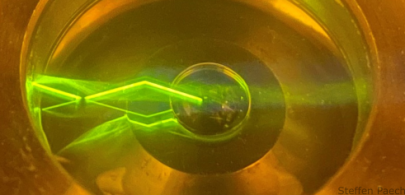With respect to nanopore functionalization we are developing strategies allowing the design of (nano)locally functionalized nanopores, functional gradients, and multifunctional nanopores.
a) Polymerization control and multifunctional nanopores
Advanced transport control in nanopores beyond gating in the first place requires precise pore editing and thus functionalization control and combination of functional groups. This holds for gradual control of nanopore accessiblity, gradient design as well as for multifunctionality in nanopores. Especially in the context of sensing, monitoring and the design of selective or coupled transport phenomena, multifunctional nanopores will be needed. Therfore, we explored different polymerization strategies to control polymer amount, polymer chain composition and polymer location in nanoporous films.
Currently involved team members: M. Zoppelt
Formerly involved team members: O. Wondra, M. Bagherabadi, C. Förster, L. Zhao, L. Despot, F. Krohm, L. Silies-Kretschmar, J. Tom, R. Brilmayer, M. Ochs
Finished Projects: LOEWE „Soft-Control“ (2011-2014), Boehringer Ingelheim Foundation (Exploration Grant) (2015-2016), LOEWE i-Napo (2016-2020), ERC StG
R. Brilmayer, C. Hess, A. Andrieu‐Brunsen, Influence of Chain Architecture on Nanopore Accessibility in Polyelectrolyte Block‐Co‐Oligomer Functionalized Mesopores, Small, 2019, 15, 1902710.
J. Tom, R. Brilmayer, J. Schmidt, A. Andrieu-Brunsen, Optimisation of Surface-Initiated Photoiniferter-Mediated Polymerisation under Confinement, and the Formation of Block Copolymers in Mesoporous Films, Polymers 2017, 9, 10, 539,
F. Krohm, J. Kind, R. Savka, M. Alcaraz Janßen, D. Herold, H. Plenio, C. M. Thiele, A. Andrieu-Brunsen, Photochromic Spiropyran- and Spirooxazine-Homopolymers in Mesoporous Thin Films by Surface Initiated ROMP, J. Mater. Chem. C, 2016
Emerging Investigators themed issue: Novel design strategies for new functional materials.
Title correction: Photochromic spiropyran- and spirooxazine-homopolymers in mesoporous thin films by surface initiated ROMP, J. Mater. Chem. C., 2016, 4, 4077-4077.
A. Andrieu-Brunsen, S. Micoureau, M. Tagliazucchi, I. Szleifer, O. Azzaroni, G. J. A. A. Soler-Illia, Mesoporous Hybrid Thin Film Membranes with PMETAC@Silica Architectures: Controlling Ionic Gating Through the Tuning of Polyelectrolyte Density, Chem. Mater., 2015, 27, 808.
L. Silies, H. Didzoleit, C. Hess, B. Stühn, A. Andrieu-Brunsen, Mesoporous Thin Films, Zwitterionic Monomers, and Iniferter-Initiated Polymerization: Polymerization in a Confined Space, Chem. Mater., 2015, 27, 1971.
b) Nanolocal functionalization
Compartmentalization and miniaturization of device components is essential e.g. to build multifunctional devices or control transport in complex systems. Transport direction will need functional (nano)gradients along nanopores. Localized detection will need (nano) local readout. We are exploring the potential of near field modes as nanoscale light source to localize polymer functionalization in three dimensions at the nanoscale. Due to the wavelength of near field modes and high resolution microscopy techniques visible light (> 470 nm) induced polymerizations are required. We develop strategies for near-field induced polymerization and visible light-induced polymerization in nanoporous materials.
Currently involved team members: M. Kirsch, M. Zoppelt, T. Hoffmann
Formerly involved team members: S. Paech, C. Förster, R. Lehn, N. Herzog, D. John
Funding: ERC StG, DFG
Finished Projects: Adolf-Messer Stiftung
M. Stanzel, L. Zhao, R. Mohammadi, R. Pardehkhorram, U. Kunz, N. Vogel (FAU Erlangen), A. Andrieu-Brunsen, Simultaneous Nanolocal Polymer and In Situ Readout Unit Placement in Mesoporous Separation Layers, Anal. Chem., 2021, 93, 13, 5394-5402.
D. John, M. Stanzel, A. Andrieu-Brunsen, Surface Plasmons and Visible Light Iniferter Initiated Polymerization for Nanolocal Functionalization of Mesoporous Separation Layers, Adv. Funct. Mater., 2021, 31,2009732.
M. Ochs, R. Mohammadi, N. Vogel, A. Andrieu-Brunsen, Wetting-controlled localized placement of surface functionalities within nanopores, Small, 2020, 16, 1906463.
N. Herzog, J. Kind, C. Hess, A. Andrieu-Brunsen, Surface Plasmons & Visible Light For Polymer Functionalization of Mespores and Manipulation of Ionic Permselectivity, Chem. Commun., 2015, 51, 11697.
c) Automated polymer writing
Automated polymer writing allows precise and faster sample fabrication. Using high-resolution microscopes we automate nanoporous layer polymer functionalization using visible-light induced polymerizations.
Currently involved team members: M. Kirsch, T. Hoffmann
Formerly involved team members: S. Paech, R. Lehn, C. Förster, D. Richter
Dominik Richter, Annette Andrieu-Brunsen, Laser-Writing of Fluorescent Copolymers in Mesoporous Silica Thin Films, Advanced Material Interfaces, 2024, 2400538.
C. Förster, R. Lehn, E. M. Saritas, A. Andrieu-Brunsen, Laser Writing of Block-Copolymer Images into Mesopores Using SBDC-Initiated Visible-Light-Induced Polymerization, Angew. Chem. 2023, e202217806.
C. Förster, R. Lehn, A. Andrieu-Brunsen, Automated Multi- and Block-Copolymer Writing in Mesoporous Films Using Visible-Light PET-RAFT and a Microscope, Small, 2023, 2207762.
C. Förster, A. Andrieu-Brunsen, Recent developments in visible light induced polymerization towards its application to nanopores, Chem. Commun., 2023, 59, 1554 – 1568.



